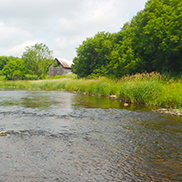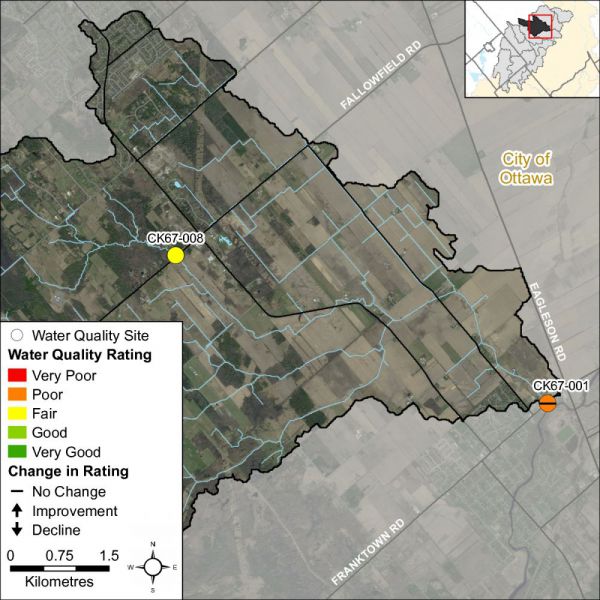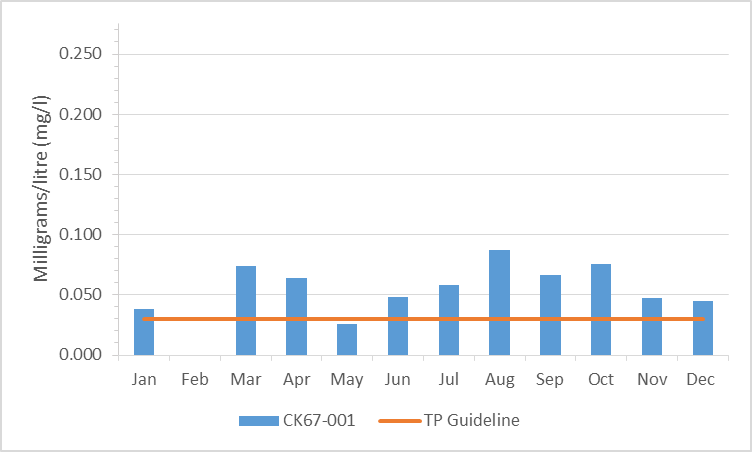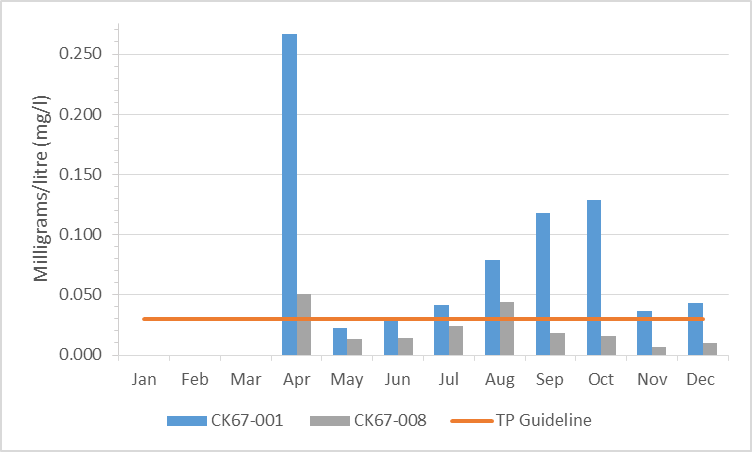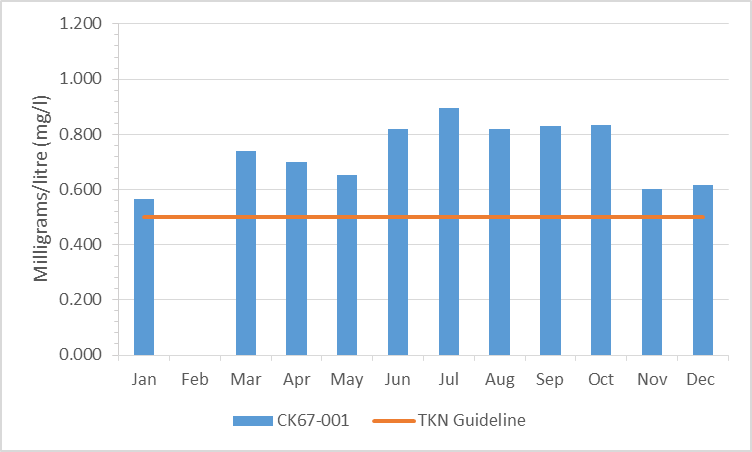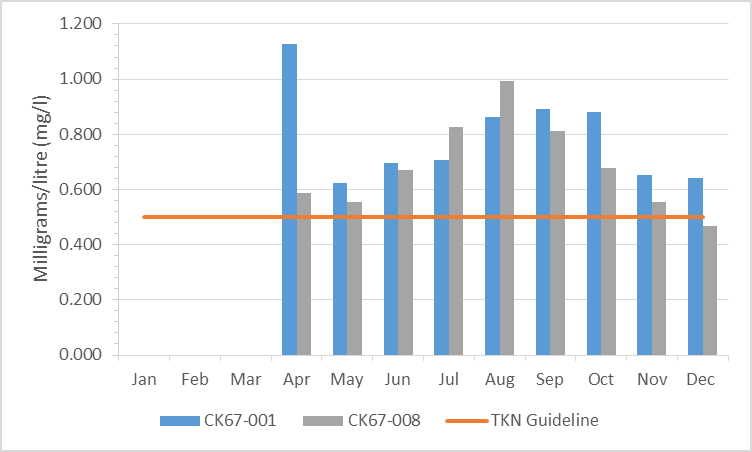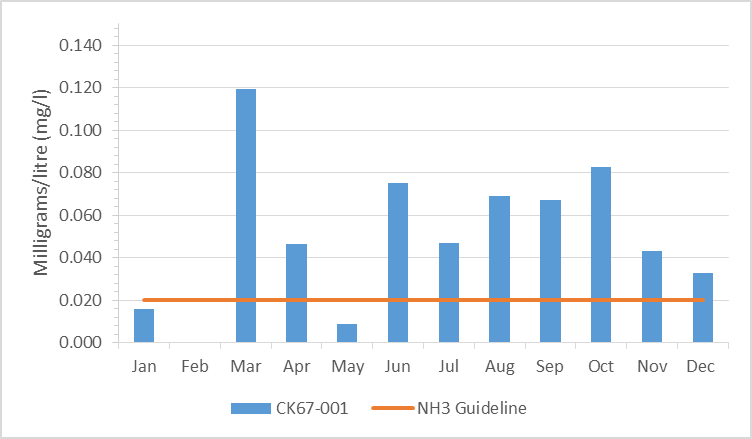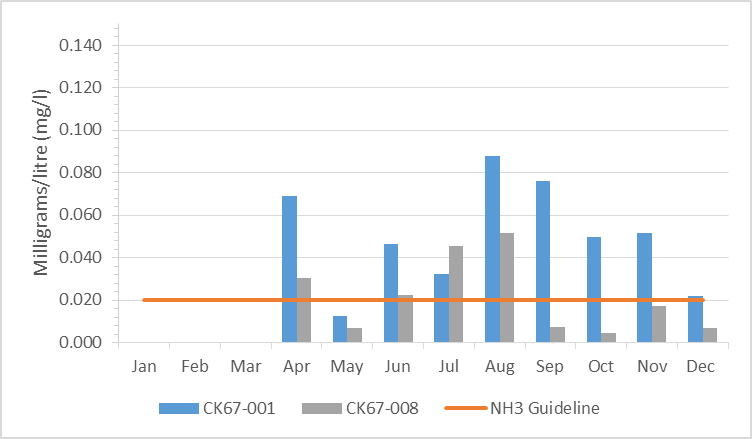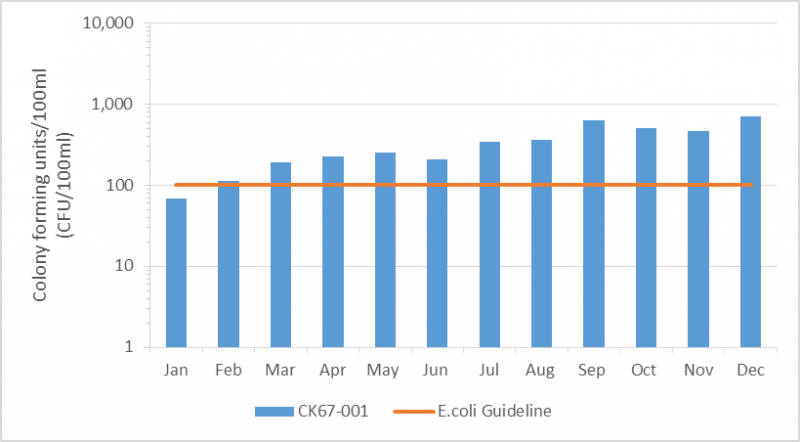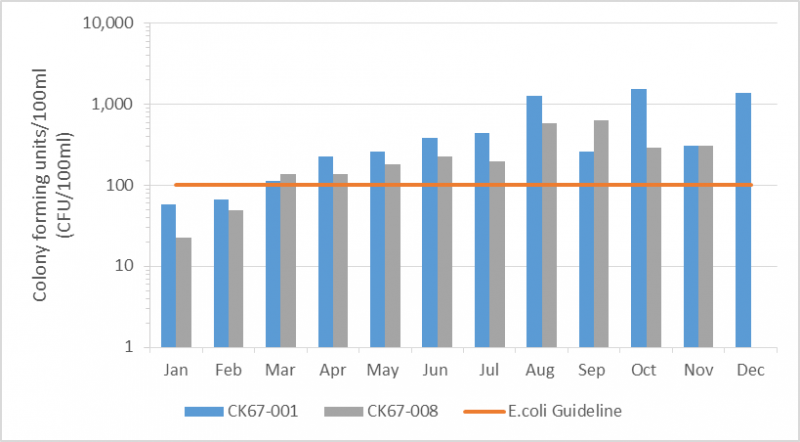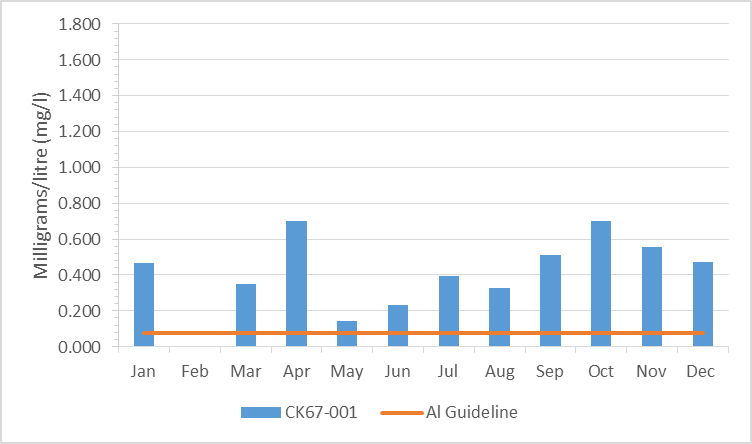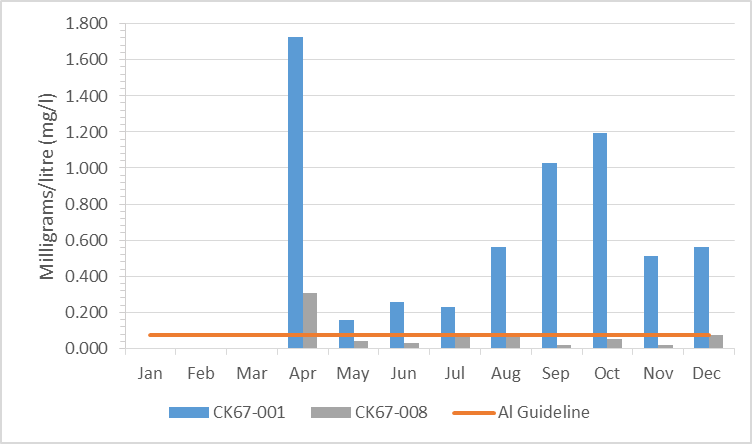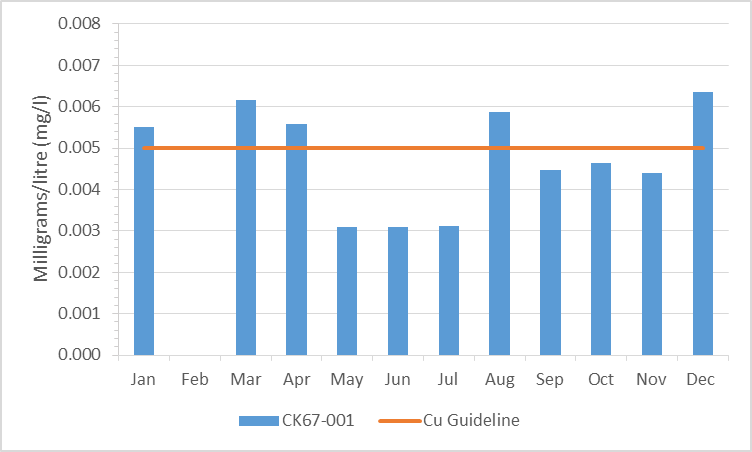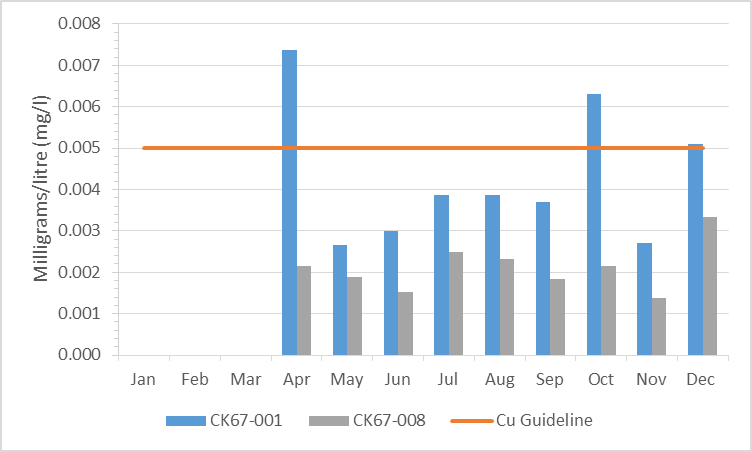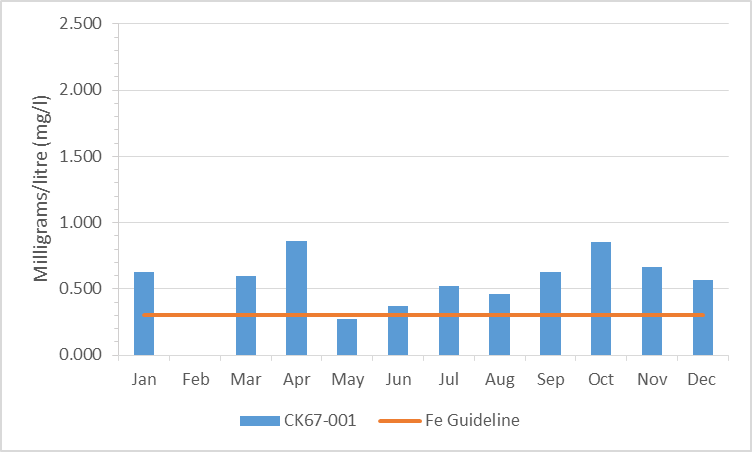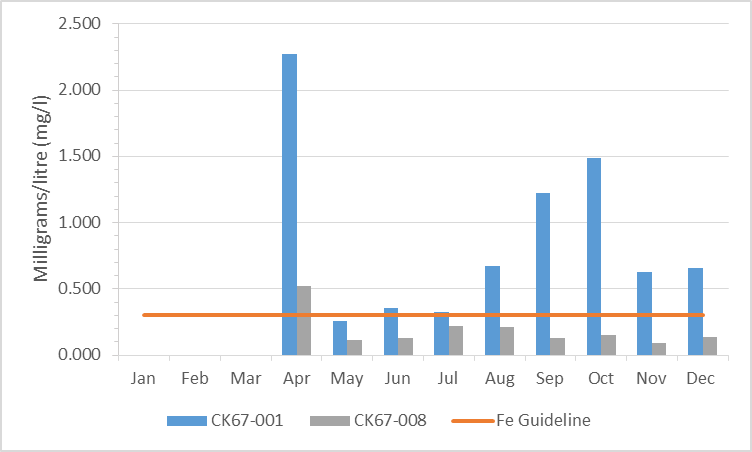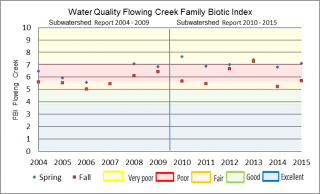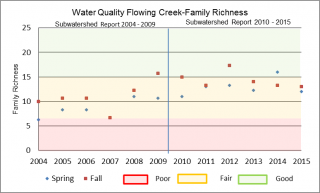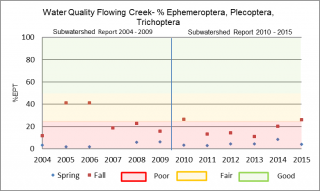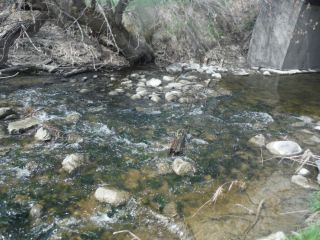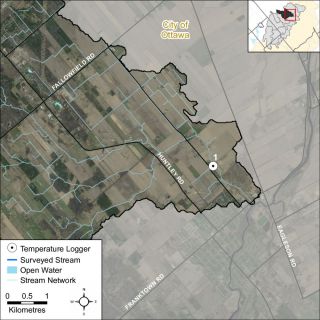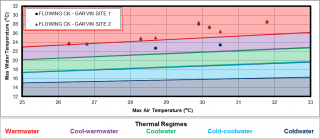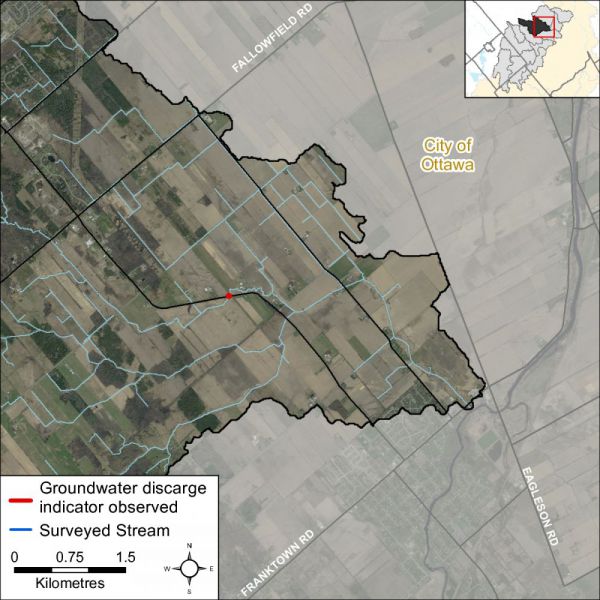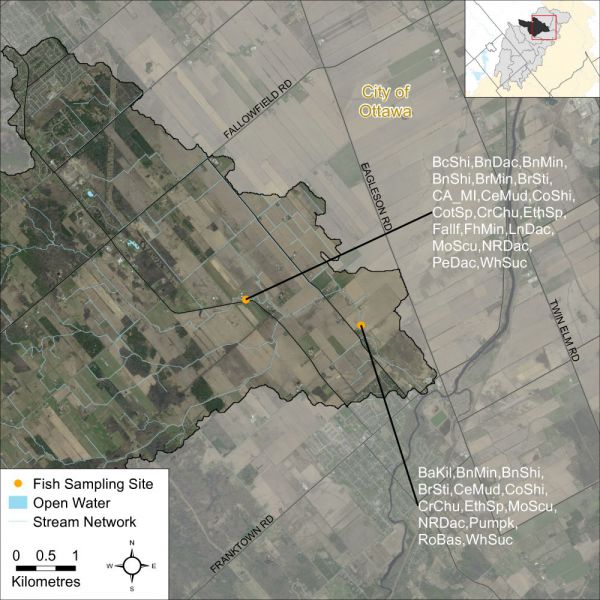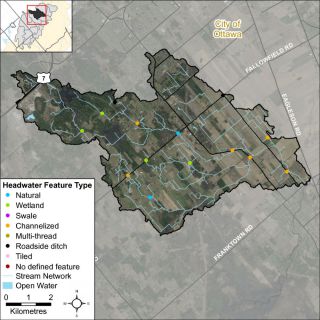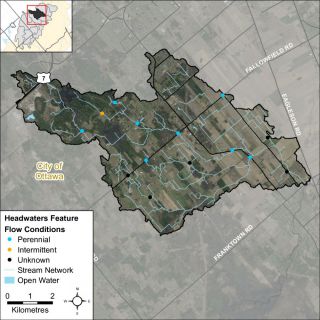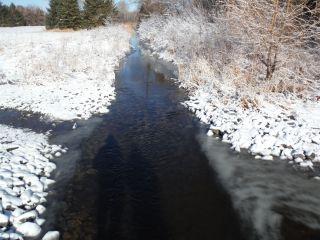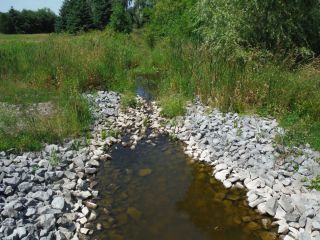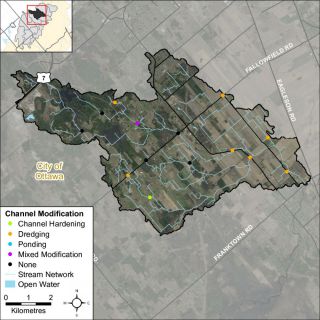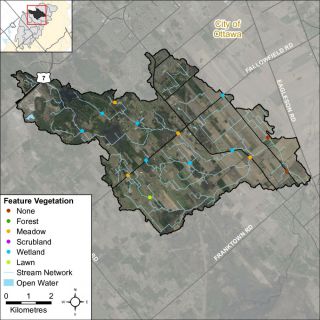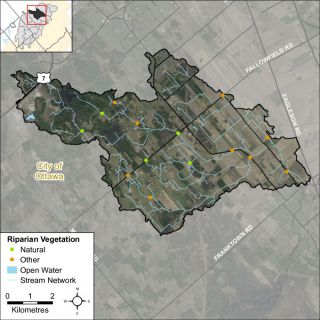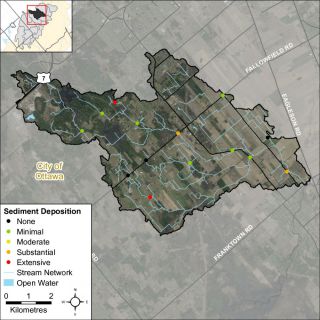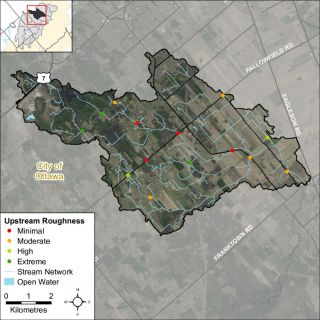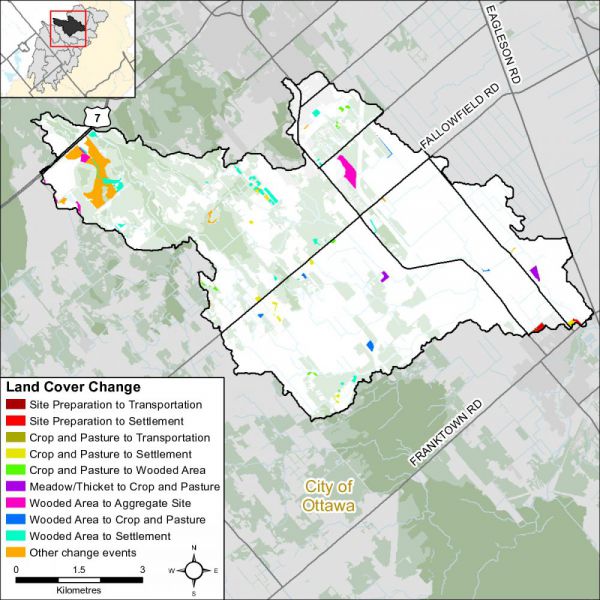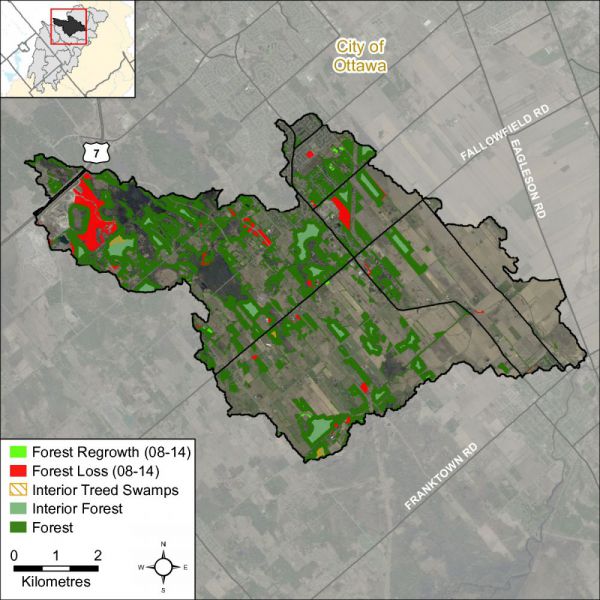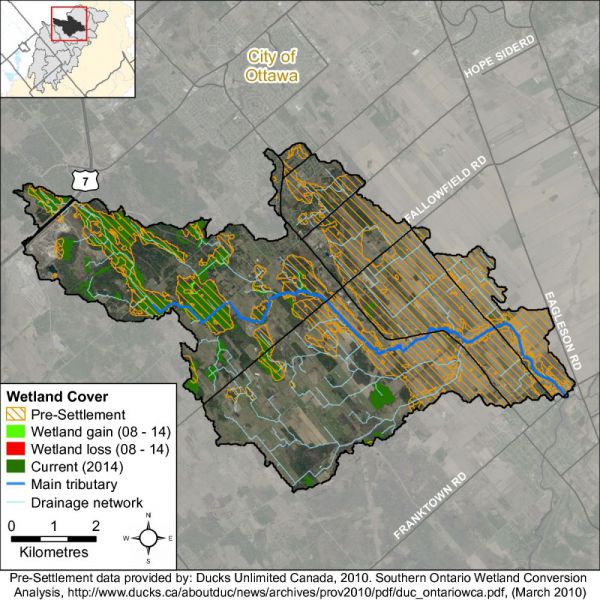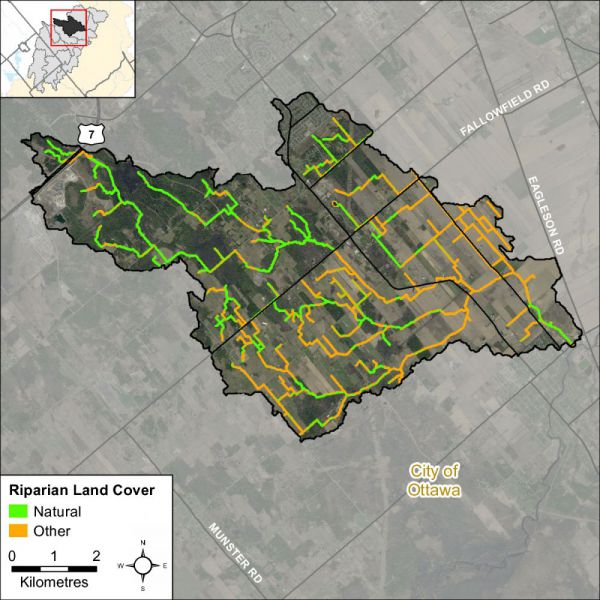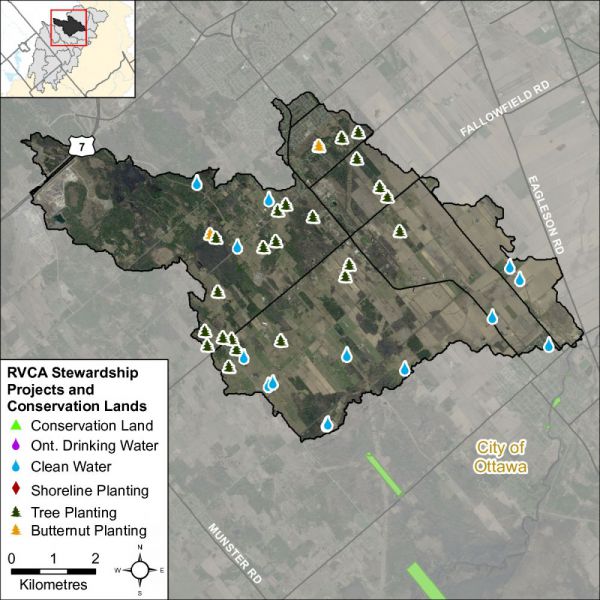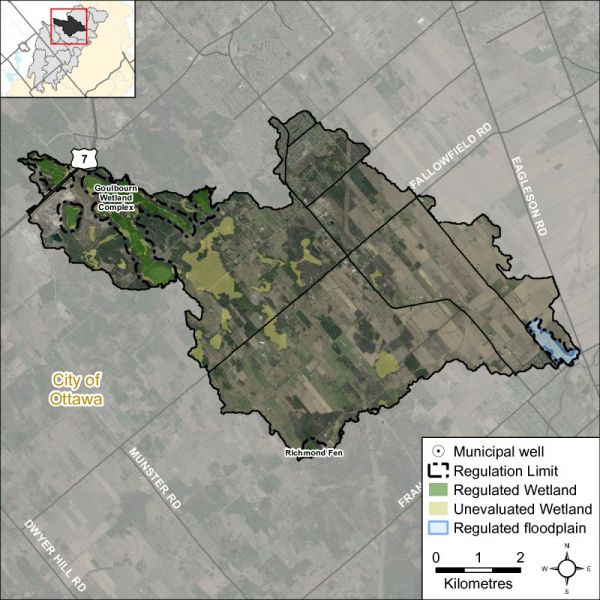Jock River Subwatershed Report 2016
FLOWING CREEK CATCHMENT
The RVCA produces individual reports for 12 catchments in the Jock River subwatershed. Using data collected and analyzed by the RVCA through its watershed monitoring and land cover classification programs, surface water quality and in-stream conditions are reported for the Jock River along with a summary of environmental conditions for the surrounding countryside every six years.
This information is used to better understand the effects of human activity on our water resources, allows us to better track environmental change over time and helps focus watershed management actions where they are needed the most to help sustain the ecosystem services (cultural, aesthetic and recreational values; provisioning of food, fuel and clean water; regulation of erosion/natural hazard protection and water purification; supporting nutrient/water cycling and habitat provision) provided by the catchment’s lands and forests and waters (Millennium Ecosystem Assessment 2005).
The following sections of this report for the Flowing Creek catchment are a compilation of that work.
| Catchment Facts |
Section 1.0 |
| Surface Water Quality Conditions |
Section 2.0 |
| Riparian Conditions |
Section 3.0 |
| Land Cover |
Section 4.0 |
| Land Stewardship and Water Resources Protection |
Section 5.0 |
| Challenges/Issues |
Section 6.0 |
| Actions/Opportunities |
Section 7.0 |
For other Jock River catchments and the Jock River Subwatershed Report, please visit the RVCA website at www.rvca.ca
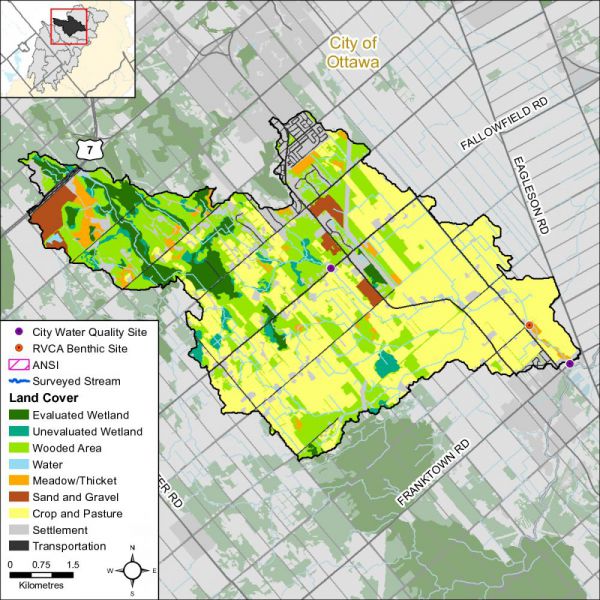
Figure 1 Land cover in the Flowing Creek catchment
1.0 Flowing Creek Catchment: Facts
1.1 General/Physical Geography
Municipalities
- Ottawa: (50 km2; 100% of catchment)
Geology/Physiography
- The Flowing Creek Catchment resides within a transitionary area between the Ottawa Valley Clay Plain to the east and the Smith Falls Limestone Plain to the West. While Champlain Sea sediment (silt and clay) lie in the eastern part of the catchment at significant depths; esker and beach sands and gravels, sand plains and some glacial till blanket the central part. Bedrock lies at the ground surface throughout the western part of the catchment and is overlain by extensive organic soils
- In this catchment, bedrock includes the interbedded limestone and dolostone, sandstone with shale and limestone, dolostone, and some limestone respectively from the Gull River, Rockcliffe, Oxford and Bobcaygeon Formations. In addition, several geologic faults may pass through the catchment
Karst/Topography
- The ground surface ranges in elevation from approximately 155 masl near Hwy 7 to approximately 92 masl at the catchment’s outlet
- Surficial karst is known to exist in the northern part of the catchment
Drainage Area
- 50 square kilometers; occupies nine percent of the Jock River subwatershed, one percent of the Rideau Valley watershed
Stream Length
- Flowing Creek and tributaries: 106 km
1.2 Vulnerable Areas
Flood/Erosion Hazard
- Flowing Creek is subject to a flooding hazard during the regional storm flood (the 100 year flood). Surveys and studies undertaken in accordance with provincial standards have determined that the 100 year flood elevation in the catchment is 93.6 metres above mean sea level for the mapped extent of the regulation limit extending from Perth Street in Richmond upstream to Garvin Road
Aquifer Vulnerability
- The Mississippi-Rideau Source Protection initiative has mapped the middle of this catchment as a significant groundwater recharge area; and the western extent of the catchment as Highly Vulnerable Aquifer. Parts of Wellhead Protection Areas (WHPA) C and D for the municipal wells in Richmond underlie the southern quarter of this catchment
Wetland Hydrology
- A watershed model developed by the RVCA in 2009 was used to study the hydrologic function of wetlands in the Rideau Valley Watershed, including those found in the Flowing Creek catchment
1.3 Conditions at a Glance
Water Quality
- Surface chemisty water quality rating in the Flowing Creek catchment is “Fair”at the upstream site (CK67-008) and “Poor” at the downstream site (CK67-001). The upstream site is largely influenced by elevated nutrient concentrations and high E. coli counts, while the downstream site reported persistently elevated nutrient concentrations and E. coli counts, as well as high metal concentrations (between 2004 to 2009 and 2010 to 2015). This points to a deterioration of water quality as it flows to the downstream reaches of Flowing Creek
- Instream biological water quality conditions for Flowing Creek are unknown
Instream and Riparian
- Overall instream and riparian condition for Flowing Creek is unknown
Thermal Regime
- Warm/cool water thermal guild supporting the Jock River fishery
Fish Community
- Twenty-four species of recreational and bait fish
Shoreline Cover Type (30 m. riparian area; 2014)
- Crop and Pasture (47%)
- Woodland (20%)
- Wetland (17%)
- Transportation (7%)
- Settlement (6%)
- Meadow-Thicket (3%)
- Aggregate (1%)
Land Cover Type (2014)
- Crop and Pasture (46%)
- Woodland (24%)
- Settlement (11%)
- Wetland (9%)
- Transportation (3%)
- Aggregate (3%)
- Meadow-Thicket (3%)
- Water (<1%)
Land Cover Change (2008 to 2014)
- Woodland (-98 ha)
- Crop and Pasture (-3 ha)
- Transportation (+1 ha)
- Wetland (+1 ha)
- Water (+2 ha)
- Aggregate (+27 ha)
- Settlement (+27 ha)
- Meadow-Thicket (+43 ha)
Significant Natural Features
- Goulbourn Provincially Significant Wetland
Water Wells
- Several hundred (~700) operational private water wells in the Flowing Creek Catchment. Groundwater uses are mainly domestic, but also include significant livestock watering, groundwater monitoring and testing, municipal and other public water supplies and commercial uses
Aggregates
- Parts of 2 bedrock quarry licenses and 4 sand and gravel pit licenses located within the catchment
Species at Risk (Elemental Occurrence)
- Spotted Turtle (Endangered)
- Blanding’s Turtle, Bobolink, Eastern Meadowlark (Threatened)
- Eastern Milksnake, Snapping Turtle, Yellow Rail (Special Concern)
1.4 Catchment Care
Stewardship
- Forty stewardship projects undertaken (see Section 5)
Environmental Monitoring
- Chemical surface (in-stream) water quality collection since 2003 (see Section 2)
- Fourteen headwater drainage feature assessments in 2015 at road crossings in the catchment. The protocol measures zero, first and second order headwater drainage features and is a rapid assessment method characterizing the amount of water, sediment transport, and storage capacity within headwater drainage features (see Section 3.2)
- Groundwater chemistry information is available from the Ontario Geological Survey for a well located in the catchment
Environmental Management
- Development along Flowing Creek and in and adjacent to the Goulbourn Provincially Significant Wetland in the catchment is subject to Ontario Regulation 174-06 (entitled “Development, Interference with Wetlands and Alterations to Shorelines and Watercourses”) that protects the hydrologic function of the wetland and also protects landowners and their property from natural hazards (flooding, fluctuating water table, unstable soils) associated with them
- Nine active Permits To Take Water (PTTW) in the Flowing Creek catchment issued for pit /quarry dewatering, industrial uses, and construction dewatering
- Ten Environmental Compliance Approvals and/or Environmental Activity and Sector Registrations in the Flowing Creek Catchment. These are mainly for municipal or private sewage works and industrial sewage works
2.0 Flowing Creek Catchment: Surface Water Quality Conditions
Surface water quality conditions in the Flowing Creek catchment are monitored by the City of Ottawa Baseline Water Quality Monitoring Program. This program provides information on the condition of Ottawa’s surface water resources; data is collected for multiple parameters including nutrients (total phosphorus, total Kjeldahl nitrogen and ammonia), E. coli, metals (like aluminum and copper) and additional chemical/physical parameters (such as alkalinity, chlorides, pH and total suspended solids). The locations of monitoring sites are shown in Figure 2 and Table 1.
Figure 2 Water quality monitoring sites on Flowing Creek
2.1 Flowing Creek Water Quality Rating
The RVCA's water quality rating for monitored sites on Flowing Creek (CK67-001 and CK67-008) range from “Poor” to “Fair” (Table 1) as determined by the Canadian Council of Ministers of the Environment (CCME) Water Quality Index (WQI)[1]. A “Fair” rating indicates that water quality is usually protected but is occasionally threatened or impaired; conditions sometimes depart from natural or desirable levels. A “Poor” rating indicates that water quality is frequently threatened or impaired; conditions often depart from natural or desirable levels. Parameters are evaluated against established guidelines to determine water quality conditions. Those parameters that frequently exceed guidelines are presented below. Analysis of the data has been broken into two periods; 2004 to 2009 and 2010 to 2015 to examine if conditions have changed between these periods. Table 1 shows the overall rating for the monitored surface water quality sites within the Flowing Creek catchment and Table 2 outlines the Water Quality Index (WQI) scores and their corresponding ratings.
Between the 2004-2009 and 2010-2015 time frames the water quality score at site CK67-001 has declined, but has retained a rating of POOR across both periods (Table 1). There is no data available for the 2004-2009 period at site CK67-008, in the 2010-2015 period the rating was determined to be FAIR with a WQI score of 74. The scores at these sites are largely influenced by frequent high nutrient concentrations. For more information on the CCME WQI, please see the Jock River Subwatershed Report.
Table 1 Water Quality Index ratings for the Flowing Creek Catchment
Table 2 Water Quality Index rations and corresponding index scores (RVCA terminology, original WQI category names in brackets)
2.2 Nutrients
Total phosphorus (TP) is used as a primary indicator of excessive nutrient loading and may contribute to abundant aquatic vegetation growth and depleted dissolved oxygen levels. The Provincial Water Quality Objective (PWQO) is used as the TP Guideline and states that in streams concentrations greater than 0.030 mg/l indicate an excessive amount of TP.
Total Kjeldahl nitrogen (TKN) and ammonia (NH3) are used as secondary indicators of nutrient loading. RVCA uses a guideline of 0.500 mg/l to assess TKN[2] and the PWQO of 0.020 mg/l to assess NH3 concentrations in the Jock River.
Tables 3, 4 and 5 summarize average nutrient concentrations at monitored sites within the Flowing Creek catchment and show the proportion of results that meet the guidelines.
Table 3 Summary of total phosphorus results for the Flowing Creek catchment, 2004-2009 and 2010-2015. Highlighted values indicate average concentrations exceed the guideline
Table 4 Summary of total Kjeldahl nitrogen results for the Flowing Creek catchment from 2004-2009 and 2010-2015. Highlighted values indicate average concentrations exceed the guideline
Table 5 Summary of ammonia results for the Flowing Creek catchment from 2004-2009 and 2010-2015. Highlighted values indicate average concentrations exceed the guideline
Monitoring Site CK67-001
The majority of samples at site CK67-001 were above the TP guideline in both the 2004-2009 and 2010-2015 periods (Figures 3, and 4) . The number of sample results below the TP guideline improved slightly from 11 percent in 2004-2009 to 27 percent in 2010-2015 (Table 3). Though more samples were below the guideline the average TP concentrations increased from 0.057 mg/l (2003–2008) to 0.082 mg/l (2009–2014).
TKN concentrations show that the bulk of results exceeded the guideline (Figures 5 and 6); 17 percent of samples were below the guideline in the 2004-2009 period, this declined to only two percent in the 2010-2015 period. The average concentration was elevated and increased from 0.746 mg/l to 0.785 mg/l (Table 4).
In the 2004-2009 reporting period 37% of NH3 results were below the guideline with an average concentration of 0.054 mg/l (Figure 7, Table 5). The percentage of results below the guideline declined to 22% in the 2010-2015 period, the average concentrations declined slightly to 0.050 mg/l (Figure 8, Table 5).
Monitoring Site CK67-008
TP results were typically below the guideline at site CK67-008; 84 percent of samples were below the guideline in the 2010-2015 period (Figure 4). The average TP concentration during this same time frame was 0.021 mg/l (Table 3).
The bulk of TKN results have exceeded the guideline (Figure 6), with 16 percent of samples below the guideline in the 2010-2015 period. The average concentration was elevated at 0.685 mg/l (Table 3).
The results for NH3 indicate that occasional exceedances occurred. Seventy-five percent of results were below the guideline in the 2010-2015 reporting period (Figure 8). The average NH3 concentration was just above the guideline at 0.022 mg/l (Table 5).
Figure 3 Total phosphorous concentrations in Flowing Creek, 2004-2009
Figure 4 Total phosphorous concentrations in Flowing Creek, 2010-2015
Figure 5 Total Kjeldahl nitrogen concentrations Flowing Creek, 2004-2009
Figure 6 Total Kjeldahl nitrogen concentrations in Flowing Creek, 2010-2015
Figure 7 Ammonia concentrations in Flowing Creek, 2004-2009
Figure 8 Ammonia concentrations in Flowing Creek, 2010-2015
Summary
Nutrient enrichment is a feature of Flowing Creek. Most nutrient parameters (total phosphorus, total Kjeldahl nitrogen and ammonia) are above guidelines at each site, apart from TP concentrations in the upstream site (CK67-008). Elevated nutrients may result in nutrient loading downstream and to the Jock River. High nutrient concentrations stimulate the growth of algae blooms and aquatic vegetation in a waterbody, and deplete oxygen levels as the vegetation dies off and decompose. Average concentrations for TP and TKN are particularly high in April, likely due to spring time runoff conditions. Increased nutrients concentrations also appear to be an issue in the late summer and early fall. Best management practices such as improved storms water management, enhanced shoreline buffers, preventing the use of fertilizers and restricting livestock access in agricultural areas can help to reduce nutrient enrichment.
2.3 Escherichia coli
E. coli is used as an indicator of bacterial pollution from human or animal waste; in elevated concentrations it can pose a risk to human health. The PWQO of 100 colony forming units/100 millilitres (CFU/100 ml) is used. E. coli counts greater than this guideline indicate that bacterial contamination may be a problem within a waterbody.
Table 6 summarizes the geometric mean[3] for the monitored sites within the Flowing Creek catchment and shows the proportion of samples that meet the E. coli guideline of 100 CFU/100 ml. The results of the geometric mean with respect to the guideline for the two periods, 2004-2009 and 2010-2015, are shown in Figures 9 and 10 respectively.
Table 6 Summary of
E. coli results for Flowing Creek, 2004-2009 and 2010-2015
Monitoring Site CK67-001
E. coli counts at site CK67-001 indicate little change with regard to bacterial contamination (Figures 9 and 10). The proportion of samples below the guideline rose marginally from 25 percent to 27 percent. The count at the geometric mean increased from 221 CFU/100ml in 2004-2009 to 262 CFU/100ml in 2010-2015 (Table 6).
Monitoring Site CK67-008
Elevated E. coli counts at site CK67-008 occurred regularly at this site (Figure 10). Forty-three percent of samples were below the guideline in the 2010-2015 period, and the count at the geometric mean was just below the PWQO at 99 CFU/100ml (Table 6).
Figure 9 Geometric mean of E. coli results in Flowing Creek, 2004-2009
Figure 10 Geometric mean of E. coli results in Flowing Creek, 2010-2015
Summary
Bacterial contamination appears to be a significant concern in Flowing Creek; at both sites (CK67-001 and CK67-008) regular exceedances occur andthe geometric mean exceeds or is just below the guideline of 100 CFU/100ml. Best management practices such as enhancing shoreline buffers and limiting livestock access should be employed wherever possible to help to improve water quality conditions on Flowing Creek and its impact on the Jock River.
2.4 Metals
Of the metals routinely monitored in Flowing Creek, aluminum (Al), copper (Cu) and iron (Fe) reported concentrations above their respective PWQOs, particularly at the downstream site (CK67-001). In elevated concentrations, these metals can have toxic effects on sensitive aquatic species. The PWQO for Al is 0.075 mg/l, for Cu it is 0.005 mg/l and Fe is 0.300 mg/l.
Tables 7, 8 and 9 summarize metal concentrations at sites CK67-001 and CK67-008, as well as show the proportion of samples that meet guidelines. Figures 11 to 16 show metal concentrations with respect to the guidelines for the two periods of interest, 2004-2009 and 2010-2015.
Table 7 Summary of aluminum results for Flowing Creek from 2004-2009 and 2010-2015. Highlighted values indicate average concentrations exceed the guideline
Table 8 Summary of copper results for Flowing Creek from 2004-2009 and 2010-2015. Highlighted values indicate average concentrations exceed the guideline
Table 9 Summary of iron results for Flowing Creek from 2004-2009 and 2010-2015. Highlighted values indicate average concentrations exceed the guideline
Monitoring Site CK67-001
The Al concentrations at site CK67-001 far exceeded the guideline. Only two percent of samples were below the guideline from 2004-2009 (Figure 11), this declined to no results reporting below the guideline from 2010-2015 (Figure 12). The average concentration increased from 0.443 mg/l to 0.664 mg/l (Table 7).
Copper concentrations occasionally exceeded the PWQO, with 70 percent of samples below the guideline in 2004-2009 (Figure 13). The Cu concentrations were consistent into the 2010-2015 period, with 71 percent of samples below the guideline in 2010-2015 (Figure 14). The average concentration of copper marginally decreased during the two reporting periods from 0.005 mg/l to 0.004 mg/l (Table 8).
Results from CK67-001 indicated that Fe concentrations exceeded the guideline. The proportion of samples below the guideline was unchanged at 25 percent between the two reporting periods (Figures 15 and 16). During the 2004-2009 reporting period average Fe concentrations were above the guideline with a concentration of 0.579 mg/l this increased to 0.845 mg/l in the 2010-2015 period (Table 9).
Monitoring Site CK67-008
Results from CK67-008 are only available for the 2010-2015 period. Results show that Al concentrations often meet the objective with 77 percent of samples below the guideline (Figure 11). The average concentration of Al was below the guideline at 0.071 mg/l (Table 7).
Copper concentrations have occasionally exceeded the guideline. In the 2010-2015 period 88 percent of samples were below the guideline (Figure 14). The average concentration was below the guideline at 0.0020 mg/l (Table 8).
The majority of Fe results were below the guideline; 88 percent of samples were below the guideline in the 2010-2015 period (Figure 16). The average concentration was below the guideline in the 2010-2015 reporting period with a concentration of 0.180 mg/l (Table 9).
Figure 11 Average aluminum concentrations in Flowing Creek, 2004-2009
Figure 12 Average aluminum concentrations in Flowing Creek, 2010-2015
Figure 13 Average copper concentrations in Flowing Creek, 2004-2009
Figure 14 Average copper concentrations in Flowing Creek, 2010-2015
Figure 15 Average iron concentrations in Flowing Creek, 2004-2009
Figure 16 Average iron concentrations in Flowing Creek, 2010-2015
Summary
Concentrations of both iron and aluminum have increased within this catchment, and average concentrations exceed the guideline at site CK67-001. There has been increased development directly upstream of this site and it is possible that these increases may be due to increased runoff from surfaces and traffic. Efforts should continue to be made to identify pollution sources and implement best management practices in both the urbanized and rural areas to reduce any inputs such as storm water runoff, metal alloys, fungicides and pesticides to improve overall stream health and lessen downstream impacts.
1 The City of Ottawa Baseline Water Quality Monitoring Program has also applied the CCME WQI to monitored sites. The parameters used and time periods differs between the RVCA and City of Ottawa’s application of the WQI, resulting in different ratings at some sites.
2 No Ontario guideline for TKN is presently available; however, waters not influenced by excessive organic inputs typically range from 0.100 to 0.500 mg/l, Environment Canada (1979) Water Quality Sourcebook, A Guide to Water Quality Parameters, Inland Waters Directorate, Water Quality Branch, Ottawa, Canada
3 A type of mean or average, which indicates the central tendency or typical value of a set of numbers by using the product of their values (as opposed to the arithmetic mean which uses their sum). It is often used to summarize a variable that varies over several orders of magnitude, such as E. coli counts
3.0 Flowing Creek Catchment: Riparian Conditions
3.1 Flowing Creek Instream Aquatic Habitat
3.1.1 Benthic Invertebrates
Freshwater benthic invertebrates are animals without backbones that live on the stream bottom and include crustaceans such as crayfish, molluscs and immature forms of aquatic insects. Benthos represent an extremely diverse group of aquatic animals and exhibit wide ranges of responses to stressors such as organic pollutants, sediments and toxicants, which allows scientists to use them as bioindicators. As part of the Ontario Benthic Biomonitoring Network (OBBN), the RVCA has been collecting benthic invertebrates at the Garvin Road site on Flowing Creek since 2004. Monitoring data is analyzed for each sample site and the results are presented using the Family Biotic Index, Family Richness and percent Ephemeroptera, Plecoptera and Trichoptera.
Hilsenhoff Family Biotic Index
The Hilsenhoff Family Biotic Index (FBI) is an indicator of organic and nutrient pollution and provides an estimate of water quality conditions for each site using established pollution tolerance values for benthic invertebrates. FBI results for Flowing Creek catchment sample location at Garvin Road are separated by reporting period 2004 to 2009 and 2010 to 2015. “Fair” to “Poor” water quality conditions were observed at the Flowing Creek sample location for the period from 2004 to 2015 (Fig.17) using a grading scheme developed by Conservation Authorities in Ontario for benthic invertebrates.
Figure 17 Hilsenhoff Family Biotic Index for Flowing Creek at the Garvin Road sample location
Family Richness
Family Richness measures the health of the community through its diversity and increases with increasing habitat diversity suitability and healthy water quality conditions. Family Richness is equivalent to the total number of benthic invertebrate families found within a sample. Flowing Creek site is reported to have “Fair” family richness (Fig.18).
Figure 18 Family Richness for Flowing Creek at the Garvin Road sample location
EPT
Ephemeroptera (Mayflies), Plecoptera (Stoneflies), and Trichoptera (Caddisflies) are species considered to be very sensitive to poor water quality conditions. High abundance of these organisms is generally an indication of good water quality conditions at a sample location. The benthic invertebrate community structure is dominated by species that are tolerant to poor water quality conditions. As a result, the EPT indicates that Flowing Creek sample location is reported to have “Poor” water quality (Fig.19) from 2004 to 2015.
Figure 19 EPT for Flowing Creek at the Garvin Road sample location
Site conditions on Flowing Creek at the Garvin Road OBBN sample location
Conclusion
Overall Flowing Creek sample location aquatic habitat conditions from a benthic invertebrate perspective is considered “Poor” from 2004 to 2015 as the samples are dominated by species that are tolerant to high organic pollution levels.
3.1.2 Thermal Regime
Many factors can influence fluctuations in stream temperature, including springs, tributaries, precipitation runoff, discharge pipes and stream shading from riparian vegetation. Water temperature is used along with the maximum air temperature (using the Stoneman and Jones method) to classify a watercourse as either warm water, cool water or cold water. Figure 20 shows where the thermal sampling sites were located on Flowing Creek. Analysis of the data collected indicates that Flowing Creek is classified as a warm water system with cool to warm water reaches (Figure 21).
Figure 20 Temperature logger locations in the Flowing Creek catchment on Garvin Road
Figure 21 Temperature logger data for the site location on Flowing Creek.
Each point on the graph represents a temperature that meets the following criteria:
- Sampling dates between July 1st and September 7th
- Sampling date is preceded by two consecutive days above 24.5 °C, with no rain
- Water temperatures are collected at 4pm
- Air temperature is recorded as the max temperature for that day
3.1.3 Groundwater
Groundwater discharge areas can influence stream temperature, contribute nutrients, and provide important stream habitat for fish and other biota. During headwater surveys, indicators of groundwater discharge are noted when observed. Indicators include: springs/seeps, watercress, iron staining, significant temperature change and rainbow mineral film. Figure 22 shows areas where one or more of the above groundwater indicators were observed during headwater drainage feature assessments.
Figure 22 Groundwater indicators observed in the Flowing Creek catchment
3.1.4 Fish Community
The Flowing Creek catchment is classified as a mixed community of warm and cool water recreational and baitfish fishery with 24 species observed. Figure 23 shows the RVCA sampling locations in the Flowing Creek catchment.
Figure 23 Flowing Creek catchment fish community
The following table contains a list of species observed in the watershed.
Table 10 Fish species observed in Flowing Creek catchment
3.2 Flowing Creek Headwater Drainage Features Assessment
3.2.1 Headwaters Sampling Locations
The RVCA Stream Characterization program assessed Headwater Drainage Features for the Jock River subwatershed in 2015. This protocol measures zero, first and second order headwater drainage features (HDF). It is a rapid assessment method characterizing the amount of water, sediment transport, and storage capacity within headwater drainage features (HDF). RVCA is working with other Conservation Authorities and the Ministry of Natural Resources and Forestry to implement the protocol with the goal of providing standard datasets to support science development and monitoring of headwater drainage features. An HDF is a depression in the land that conveys surface flow. Additionally, this module provides a means of characterizing the connectivity, form and unique features associated with each HDF (OSAP Protocol, 2013). In 2015 the program sampled 14 sites at road crossings in the Flowing Creek catchment area (Figure 24).
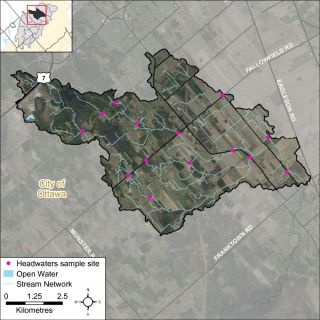
Figure 24 Locations of the headwater sampling sites in the Flowing Creek catchment
3.2.2 Headwater Feature Type
The headwater sampling protocol assesses the feature type in order to understand the function of each feature. The evaluation includes the following classifications: defined natural channel, channelized or constrained, multi-thread, no defined feature, tiled, wetland, swale, roadside ditch and pond outlet. By assessing the values associated with the headwater drainage features in the catchment area we can understand the ecosystem services that they provide to the watershed in the form of hydrology, sediment transport, and aquatic and terrestrial functions. Six features were classified as having been channelized, four features were classified as wetland, two features were road side ditches and two features were identified as natural. Figure 25 shows the feature type of the primary feature at the sampling locations.
Figure 25 Headwater feature types in the Flowing Creek catchment
3.2.3 Headwater Feature Flow
The observed flow condition within headwater drainage features can be highly variable depending on timing relative to the spring freshet, recent rainfall, soil moisture, etc. Flow conditions are assessed in the spring and in the summer to determine if features are perennial and flow year round, if they are intermittent and dry up during the summer months or if they are ephemeral systems that do not flow regularly and generally respond to specific rainstorm events or snowmelt. Flow conditions in headwater systems can change from year to year depending on local precipitation patterns. Figure 26 shows the observed flow conditions at the sampling locations in the Flowing Creek catchment in 2015.
Figure 26 Headwater feature flow conditions in the Flowing Creek catchment
A spring photo of the headwater sample site in the Flowing Creek catchment located on Flewellyn Road
A summer photo of the headwater sample site in the Flowing Creek catchment located on Flewellyn Road
3.2.4 Feature Channel Modifications
Many of the headwater drainage features within the Flowing Creek catchment area are classified as municipal drains. Channel modifications were assessed at each headwater drainage feature sampling location. Modifications include dredging, channel hardening and mixed modifications. The Flowing Creek catchment area had five features with no modifications, one feature was classified as being hardened, seven classified as dredged and one was identified as having mixed modifications. Figure 27 shows the channel modifications observed at the sampling locations for Flowing Creek.
Figure 27 Headwater feature channel modifications in the Flowing Creek catchment
3.2.5 Headwater Feature Vegetation
Headwater feature vegetation evaluates the type of vegetation that is found within the drainage feature. The type of vegetated within the channel influences the aquatic and terrestrial ecosystem values that the feature provides. For some types of headwater features the vegetation within the feature plays a very important role in flow and sediment movement and provides fish and wildlife habitat. The following classifications are evaluated no vegetation, lawn, wetland, meadow, scrubland and forest. The features assessed in the Flowing Creek catchment were classified as being dominated by wetland and meadow vegetation. Two features were classified as having no vegetation and one feature was dominated by recently cut grasses (lawn) within the channel. Figure 28 depicts the dominant vegetation observed at the sampled headwater sites in the Flowing Creek catchment.
Figure 28 Headwater feature vegetation types in the Flowing Creek catchment
3.2.6 Headwater Feature Riparian Vegetation
Headwater riparian vegetation evaluates the type of vegetation that is found along the adjacent lands of a headwater drainage feature. The type of vegetation within the riparian corridor influences the aquatic and terrestrial ecosystem values that the feature provides to the watershed. Five sample locations in Flowing Creek were dominated by natural vegetation in the form of scrubland and meadow vegetation. Nine sample locations were dominated by other forms of vegetation of either crops or ornamental grasses. Figure 29 depicts the type of riparian vegetation observed at the sampled headwater sites in the Flowing Creek catchment.
Figure 29 Headwater feature riparian vegetation types in the Flowing Creek catchment
3.2.7 Headwater Feature Sediment Deposition
Assessing the amount of recent sediment deposited in a channel provides an index of the degree to which the feature could be transporting sediment to downstream reaches (OSAP, 2013). Evidence of excessive sediment deposition might indicate the requirement to follow up with more detailed targeted assessments upstream of the site location to identify potential best management practices to be implemented. Conditions ranged from no deposition observed to extensive deposition recorded. Figure 30 depicts the degree of sediment deposition observed at the sampled headwater sites in the Flowing Creek catchment.
Figure 30 Headwater feature sediment deposition in the Flowing Creek catchment
3.2.8 Headwater Feature Upstream Roughness
Feature roughness will provide a measure of the amount of materials within the bankfull channel that could slow down the velocity of water flowing within the headwater feature (OSAP, 2013). Materials on the channel bottom that provide roughness include vegetation, woody debris and boulders/cobble substrates. Roughness can provide benefits in mitigating downstream erosion on the headwater drainage feature and the receiving watercourse by reducing velocities. Roughness also provides important habitat conditions for aquatic organisms. The sample locations in the Flowing Creek catchment area ranged from minimal to extreme roughness conditions. Figure 31 shows the feature roughness conditions at the sampling locations in the Flowing Creek catchment.
Figure 31 Headwater feature roughness in the Flowing Creek catchment
4.0 Flowing Creek Catchment: Land Cover
Land cover and any change in coverage that has occurred over a six year period is summarized for the Flowing Creek catchment using spatially continuous vector data representing the catchment during the spring of 2008 and 2014. This dataset was developed by the RVCA through heads-up digitization of 20cm DRAPE ortho-imagery at a 1:4000 scale and details the surrounding landscape using 10 land cover classes.
4.1 Flowing Creek Catchment Change
As shown in Table 11 and Figure 1, the dominant land cover type in 2014 was crop and pastureland followed by woodland.
Table 11 Land cover (2008 vs. 2014) in the Flowing Creek catchment
* Does not include treed swamps ** Includes treed swamps
From 2008 to 2014, there was an overall change of 145 hectares (from one land cover class to another). Much of the change in the Flowing Creek catchment is a result of the conversion of woodland to meadow-thicket (shown in Figure 32 as “Other change event”), settlement and aggregates.
Figure 32 Land cover change in the Flowing Creek catchment (2014)
Table 12 provides a detailed breakdown of all land cover change that has taken place in the Flowing Creek catchment between 2008 and 2014.
Table 12 Land cover change in the Flowing Creek catchment (2008 to 2014)
4.2 Woodland Cover
In the Environment Canada Guideline (Third Edition) entitled “How Much Habitat Is Enough?” (hereafter referred to as the “Guideline”) the opening narrative under the Forest Habitat Guidelines section states that prior to European settlement, forest was the predominant habitat in the Mixedwood Plains ecozone. The remnants of this once vast forest now exist in a fragmented state in many areas (including the Rideau Valley watershed) with woodland patches of various sizes distributed across the settled landscape along with higher levels of forest cover associated with features such as the Frontenac Axis (within the on-Shield areas of the Rideau Lakes and Tay River subwatersheds). The forest legacy, in terms of the many types of wildlife species found, overall species richness, ecological functions provided and ecosystem complexity is still evident in the patches and regional forest matrices (found in the Jock River subwatershed and elsewhere in the Rideau Valley watershed). These ecological features are in addition to other influences which forests have on water quality and stream hydrology including reducing soil erosion, producing oxygen, storing carbon along with many other ecological services that are essential not only for wildlife but for human well-being.
The Guideline also notes that forests provide a great many habitat niches that are in turn occupied by a great diversity of plant and animal species. They provide food, water and shelter for these species - whether they are breeding and resident locally or using forest cover to help them move across the landscape. This diversity of species includes many that are considered to be species at risk. Furthermore, from a wildlife perspective, there is increasing evidence that the total forest cover in a given area is a major predictor of the persistence and size of bird populations, and it is possible or perhaps likely that this pattern extends to other flora and fauna groups. The overall effect of a decrease in forest cover on birds in fragmented landscapes is that certain species disappear and many of the remaining ones become rare, or fail to reproduce, while species adapted to more open and successional habitats, as well as those that are more tolerant to human-induced disturbances in general, are able to persist and in some cases thrive. Species with specialized-habitat requirements are most likely to be adversely affected. The overall pattern of distribution of forest cover, the shape, area and juxtaposition of remaining forest patches and the quality of forest cover also play major roles in determining how valuable forests will be to wildlife and people alike.
The current science generally supports minimum forest habitat requirements between 30 and 50 percent, with some limited evidence that the upper limit may be even higher, depending on the organism/species phenomenon under investigation or land-use/resource management planning regime being considered/used.
As shown in Figure 33, 25 percent of the Flowing Creek catchment contains 1242 hectares of upland forest and 44 hectares of lowland forest (treed swamps) versus the 26 percent of woodland cover in the Jock River subwatershed. This is less than the 30 percent of forest cover that is identified as the minimum threshold required to sustain forest birds according to the Guideline and which may only support less than one half of potential species richness and marginally healthy aquatic systems. When forest cover drops below 30 percent, forest birds tend to disappear as breeders across the landscape.
Figure 33 Woodland cover and forest interior (2014)
4.2.1 Woodland (Patch) Size
According to the Ministry of Natural Resources’ Natural Heritage Reference Manual (Second Edition), larger woodlands are more likely to contain a greater diversity of plant and animal species and communities than smaller woodlands and have a greater relative importance for mobile animal species such as forest birds.
Bigger forests often provide a different type of habitat. Many forest birds breed far more successfully in larger forests than they do in smaller woodlots and some rely heavily on forest interior conditions. Populations are often healthier in regions with more forest cover and where forest fragments are grouped closely together or connected by corridors of natural habitat. Small forests support small numbers of wildlife. Some species are “area-sensitive” and tend not to inhabit small woodlands, regardless of forest interior conditions. Fragmented habitat also isolates local populations, especially small mammals, amphibians and reptiles with limited mobility. This reduces the healthy mixing of genetic traits that helps populations survive over the long run (Conserving the Forest Interior. Ontario Extension Notes, 2000).
The Environment Canada Guideline also notes that for forest plants that do not disperse broadly or quickly, preservation of some relatively undisturbed large forest patches is needed to sustain them because of their restricted dispersal abilities and specialized habitat requirements and to ensure continued seed or propagation sources for restored or regenerating areas nearby.
The Natural Heritage Reference Manual continues by stating that a larger size also allows woodlands to support more resilient nutrient cycles and food webs and to be big enough to permit different and important successional stages to co-exist. Small, isolated woodlands are more susceptible to the effects of blowdown, drought, disease, insect infestations, and invasions by predators and non-indigenous plants. It is also known that the viability of woodland wildlife depends not only on the characteristics of the woodland in which they reside, but also on the characteristics of the surrounding landscape where the woodland is situated. Additionally, the percentage of forest cover in the surrounding landscape, the presence of ecological barriers such as roads, the ability of various species to cross the matrix surrounding the woodland and the proximity of adjacent habitats interact with woodland size in influencing the species assemblage within a woodland.
In the Flowing Creek catchment (in 2014), eighty-two (46 percent) of the 179 woodland patches are very small, being less than one hectare in size. Another 82 (46 percent) of the woodland patches ranging from one to less than 20 hectares in size tend to be dominated by edge-tolerant bird species. The remaining 15 (8 percent of) woodland patches range between 26 and 102 hectares in size. Fourteen of these patches contain woodland between 20 and 100 hectares and may support a few area-sensitive species and some edge intolerant species, but will be dominated by edge tolerant species.
Conversely, one (less than one percent) of the 179 woodland patches in the drainage area exceeds the 100 plus hectare size needed to support most forest dependent, area sensitive birds and are large enough to support approximately 60 percent of edge-intolerant species. No patch tops 200 hectares, which according to the Environment Canada Guideline will support 80 percent of edge-intolerant forest bird species (including most area sensitive species) that prefer interior forest habitat conditions.
Table 13 presents a comparison of woodland patch size in 2008 and 2014 along with any changes that have occurred over that time. A decrease (of 96 ha) has been observed in the overall woodland patch area between the two reporting periods with change spread across all woodland patch size class ranges (except the less than one hectare class).
Table 13 Woodland patches in the Flowing Creek catchment (2008 and 2014)
*Includes treed swamps
4.2.2 Woodland (Forest) Interior Habitat
The forest interior is habitat deep within woodlands. It is a sheltered, secluded environment away from the influence of forest edges and open habitats. Some people call it the “core” or the “heart” of a woodland. The presence of forest interior is a good sign of woodland health, and is directly related to the woodland’s size and shape. Large woodlands with round or square outlines have the greatest amount of forest interior. Small, narrow woodlands may have no forest interior conditions at all. Forest interior habitat is a remnant natural environment, reminiscent of the extensive, continuous forests of the past. This increasingly rare forest habitat is now a refuge for certain forest-dependent wildlife; they simply must have it to survive and thrive in a fragmented forest landscape (Conserving the Forest Interior. Ontario Extension Notes, 2000).
The Natural Heritage Reference Manual states that woodland interior habitat is usually defined as habitat more than 100 metres from the edge of the woodland and provides for relative seclusion from outside influences along with a moister, more sheltered and productive forest habitat for certain area sensitive species. Woodlands with interior habitat have centres that are more clearly buffered against the edge effects of agricultural activities or more harmful urban activities than those without.
In the Flowing Creek catchment (in 2014), the 179 woodland patches contain 48 forest interior patches (Figure 33) that occupy two percent (106 ha.) of the catchment land area (which is less than the three percent of interior forest in the Jock River Subwatershed). This is below the ten percent figure referred to in the Environment Canada Guideline that is considered to be the minimum threshold for supporting edge intolerant bird species and other forest dwelling species in the landscape.
Most patches (45) have less than 10 hectares of interior forest, 28 of which have small areas of interior forest habitat less than one hectare in size. The remaining three patches contain interior forest between 16 and 17 hectares in area. Between 2008 and 2014, there has been a change in the number of woodland patches containing smaller areas of interior habitat with an overall loss of 23 hectares in the catchment (Table 14), suggesting an increase in forest fragmentation over the six year period.
Table 14 Woodland Interior in the Flowing Creek catchment (2008 and 2014)
4.3 Wetland Cover
Wetlands are habitats forming the interface between aquatic and terrestrial systems. They are among the most productive and biologically diverse habitats on the planet. By the 1980s, according to the Natural Heritage Reference Manual, 68 percent of the original wetlands south of the Precambrian Shield in Ontario had been lost through encroachment, land clearance, drainage and filling.
Wetlands perform a number of important ecological and hydrological functions and provide an array of social and economic benefits that society values. Maintaining wetland cover in a watershed provides many ecological, economic, hydrological and social benefits that are listed in the Reference Manual and which may include:
- contributing to the stabilization of shorelines and to the reduction of erosion damage through the mitigation of water flow and soil binding by plant roots
- mitigating surface water flow by storing water during periods of peak flow (such as spring snowmelt and heavy rainfall events) and releasing water during periods of low flow (this mitigation of water flow also contributes to a reduction of flood damage)
- contributing to an improved water quality through the trapping of sediments, the removal and/or retention of excess nutrients, the immobilization and/or degradation of contaminants and the removal of bacteria
- providing renewable harvesting of timber, fuel wood, fish, wildlife and wild rice
- contributing to a stable, long-term water supply in areas of groundwater recharge and discharge
- providing a high diversity of habitats that support a wide variety of plants and animals
- acting as “carbon sinks” making a significant contribution to carbon storage
- providing opportunities for recreation, education, research and tourism
Historically, the overall wetland coverage within the Great Lakes basin exceeded 10 percent, but there was significant variability among watersheds and jurisdictions, as stated in the Environment Canada Guideline. In the Rideau Valley Watershed, it has been estimated that pre-settlement wetland cover averaged 35 percent using information provided by Ducks Unlimited Canada (2010) versus the 21 percent of wetland cover existing in 2014 derived from DRAPE imagery analysis.
Using the same dataset, it is estimated that pre-settlement (historic) wetland cover averaged 51 percent in the Jock River subwatershed versus the 24 percent of cover existing in 2014 (as summarized in Table 15).
Table 15 Wetland cover in the Jock River subwatershed and Flowing Creek catchment (Historic to 2014)
This decline in wetland cover is also evident in the Flowing Creek catchment (as seen in Figure 34) where wetland was reported to cover 45 percent of the area prior to settlement, as compared to 10 percent in 2014. This represents a 79 percent loss of historic wetland cover and what remains (in 2014) falls below the 40 percent historic wetland threshold cited in the Environment Canada Guideline for maintaining key ecological and hydrological functions. To maintain critical hydrological, ecological functions along with related recreational and economic benefits provided by these wetland habitats in the catchment, the Guideline recommends a “no net loss” approach for currently existing wetlands combined with efforts to work towards restoring upwards of 40 percent of the historic wetland coverage, where feasible.
Figure 34 Flowing Creek catchment wetland cover
4.4 Shoreline Cover
The riparian or shoreline zone is that special area where the land meets the water. Well-vegetated shorelines are critically important in protecting water quality and creating healthy aquatic habitats, lakes and rivers. Natural shorelines intercept sediments and contaminants that could impact water quality conditions and harm fish habitat in streams. Well established buffers protect the banks against erosion, improve habitat for fish by shading and cooling the water and provide protection for birds and other wildlife that feed and rear young near water. A recommended target (from the Environment Canada Guideline) is to maintain a minimum 30 metre wide vegetated buffer along at least 75 percent of the length of both sides of rivers, creeks and streams.
Figure 35 shows the extent of the ‘Natural’ vegetated riparian zone (predominantly wetland/woodland features) and ‘Other’ anthropogenic cover (crop/pastureland, roads/railways, settlements) along a 30-metre-wide area of land, both sides of the shoreline of the Jock River and its tributaries in the Flowing Creek catchment.
Figure 35 Natural and other riparian land cover in the Flowing Creek catchment
This analysis shows that the riparian zone in the Flowing Creek catchment in 2014 was comprised of crop and pastureland (47 percent), woodland (20 percent), wetland (17 percent), transportation (seven percent), settlement (six percent), meadow-thicket (three percent) and aggregate (one percent). Additional statistics for the Flowing Creek catchment are presented in Table 16. Of particular interest is the observed increase in the area of “Aggregate” and decrease in "Woodland" area along the shoreline of Flowing Creek and tributaries over a six year period.
Table 16 Riparian land cover (2008 vs. 2014) in the Flowing Creek catchment
5.0 Flowing Creek Catchment: Stewardship and Water Resources Protection
The RVCA and its partners are working to protect and enhance environmental conditions in the Jock River Subwatershed. Figure 36 shows the location of all stewardship projects completed in the Flowing Creek catchment along with sites identified for potential shoreline restoration.
5.1 Rural Clean Water Projects
From 2010 to 2015, two well decommissionings, one windbreak buffer and one precision farming project were completed. Between 2004 and 2009, two crop residue projects, two well upgrades, one septic system replacement, one well decommissioning, one livestock fencing and one clean water diversion were completed. Prior to 2004, four livestock fencing projects, one milkhouse wastewater treatment facility, one manure storage/wastewater runoff project and one crop residue project were completed. Six of these projects were completed within the 30 metre riparian zone of Flowing Creek and tributaries. Total value of all 19 projects is $125,040 with $40,796 of that amount funded through grant dollars from the RVCA.
Figure 36 Stewardship site locations
5.2 Private Land Forestry Projects
The location of RVCA tree planting projects is shown in Figure 36. From 2010 to 2015, 1,000 trees were planted at one site. Between 2004 and 2009, 11,700 trees were planted at two sites and prior to 2004, 91,040 trees were planted at 18 sites. In total, 103,740 trees were planted, resulting in the reforestation of 54 hectares. Three of these projects were completed within the 30 metre riparian zone of Flowing Creek and tributaries. Total value of all 21 projects is $353,576 with $119,765 of that amount coming from fundraising sources.
Through the RVCA Butternut Recovery Program, an additional 50 butternut trees were planted in the Rideau Creek catchment (Figure 36) between 2004 and 2015, as part of efforts to introduce healthy seedlings from tolerant butternuts into various locations across Eastern Ontario.
5.3 Valley, Stream, Wetland and Hazard Lands
The Flowing Creek catchment covers 50.4 square kilometres with 4.6 square kilometres (or nine percent) of the drainage area being within the regulation limit of Ontario Regulation 174/06 (Figure 37), giving protection to wetland areas and river or stream valleys that are affected by flooding and erosion hazards.
Wetlands occupy 4.7 sq. km. (or nine percent) of the catchment. Of these wetlands, 3.1 sq. km (or 65 percent) are designated as provincially significant and included within the RVCA regulation limit. This leaves the remaining 1.6 sq. km (or 35 percent) of wetlands in the catchment outside the regulated area limit.
Of the 106.5 kilometres of stream in the catchment, regulation limit mapping has been plotted along 13.7 kilometers of streams (representing 13 percent of all streams in the catchment). Some of these regulated watercourses (9.2 km or nine percent of all streams) flow through regulated wetlands; the remaining 4.6 km (or 33 percent) of regulated streams are located outside of those wetlands. Plotting of the regulation limit on the remaining 92.7 km (or 87 percent) of streams requires identification of flood and erosion hazards and valley systems.
Within those areas of the Flowing Creek catchment subject to the regulation (limit), efforts (have been made and) continue through RVCA planning and regulations input and review to manage the impact of development (and other land management practices) in areas where “natural hazards” are associated with rivers, streams, valley lands and wetlands. For areas beyond the regulation limit, protection of the catchment’s watercourses is only provided through the “alteration to waterways” provision of the regulation.
Figure 37 RVCA regulation limits
5.4 Vulnerable Drinking Water Areas
The Wellhead Protection Area around the Richmond (King’s Park) municipal drinking water source extends into the Flowing Creek drainage catchment. This area is subject to mandatory policies in the Mississippi-Rideau Source Protection Plan developed under the Clean Water Act. These policies specifically regulate land uses and activities that are considered drinking water threats, thereby reducing the risk of contamination of the municipal drinking water source.
The Flowing Creek drainage catchment is also considered to have a Highly Vulnerable Aquifer. This means that the nature of the overburden (thin soils, fractured bedrock) does not provide a high level of protection for the underlying groundwater making the aquifer more vulnerable to contaminants released on the surface. The Mississippi-Rideau Source Protection Plan includes policies that focus on the protection of groundwater region-wide due to the fact that most of the region, which encompasses the Mississippi and Rideau watersheds, is considered Highly Vulnerable Aquifer.
A large portion of the central part of this catchment area is also considered a Significant Groundwater Recharge Area. This means that there is a volume of water moving from the surface into the ground and groundwater serves either as a municipal drinking water source or supplies a coldwater ecosystem such as a brook trout stream. The Plan was not required to include policies to specifically address Significant Groundwater Recharge Areas.
For detailed maps and policies that have been developed to protect drinking water sources, please go to the Mississippi-Rideau Source Protection Region website at www.mrsourcewater.ca to view the Mississippi-Rideau Source Protection Plan.
6.0 Flowing Creek Catchment: Challenges/Issues
Water Quality/Quantity
Surface chemistry water quality on Flowing Creek declines from “Fair” to “Poor” between the upstream ((CK67-008) and downstream sites (CK67-001). The lower site has shown persistently elevated nutrient concentrations and E. coli counts as well as high metal concentrations over a 12 year period.
Instream biological water quality conditions for Flowing Creek are unknown.
Drainage problems have led to establishment of altered wetland conditions and land use conflict (amongst development, quarry, agriculture and wetland conservation interests).
Existing hydrological and geochemical datasets and assessments (academic, RVCA, others) are only recently available and/or are not being considered in the characterization of the numerous hydrologic functions of the Jock River subwatershed. Further, there is a dearth of hydrologic information (hydroperiod, groundwater/surface water interactions, geochemistry) about the wetlands that remain in the Jock River subwatershed.
Natural hazard lands have not been identified.
Headwaters/Instream/Shorelines
‘Natural’ vegetation covers 39 percent of the riparian zone of Flowing Creek and its tributaries (Figure 34) and is below the recommended 30 metre wide, naturally vegetated target along 75 percent of the length of the catchment’s watercourses.
No information available about instream aquatic and riparian conditions along Flowing Creek.
Land Cover
Woodlands cover 25 percent of the catchment and is below the 30 percent of forest cover that is identified as the minimum threshold for sustaining forest birds and other woodland dependent species (Figure 32).
Pre-settlement wetlands have declined by 79 percent and now cover nine percent (483 ha.) of the catchment (Figure 33). Thirty-four percent (167 ha.) of these wetlands remain unevaluated/unregulated and are vulnerable to drainage and land clearing activities in the absence of any regulatory and planning controls that would otherwise protect them for the many important hydrological, social, biological and ecological functions/services/values they provide to landowners and the surrounding community.
7.0 Flowing Creek Catchment: Opportunities/Actions
Water Quality/Quantity
Implement improved storm water and agricultural best management practices to address water quality concerns and retain existing shoreline vegetation. The Rural Clean Water Programs offer grants to landowners interested in implementing projects on their property that will help to protect and improve water quality:
- Homeowners may be interested in projects to repair, replace or upgrade their well or septic system, or addressing erosion through buffer plantings and erosion control
- Farmers can take advantage of a wide range of projects, including livestock fencing, manure storage, tile drainage control structures, cover crops, and many more
Continue to coordinate environmental monitoring and reporting activities with the City of Ottawa
Use wetland restoration as a tool to improve surface water quality and help restore the hydrologic integrity of the Jock River and its tributaries, including Flowing Creek
List, share and when possible, synthesize and use existing hydrological and geochemical datasets and assessment outcomes to facilitate the characterization of subwatershed and catchment hydrological functions. In addition, prepare guidance on best practices for the preparation of water budget assessments to better understand the hydrologic cycle requirements that occur at site specific scales; and share existing catchment and subwatershed scale water budget assessment outcomes
Flewellyn Special Study Area, Cumulative Effects Study has been initiated by the City of Ottawa to better understand the hydrology in the area and associated drainage concerns
Flowing Creek flood risk is being studied as part of ongoing efforts to prepare flood plain mapping for the Jock River subwatershed
Headwaters/Instream/Shorelines
Promote the Rideau Valley Shoreline Naturalization Program to landowners to increase existing 39 percent of natural shoreline cover
Educate landowners about the value of and best management practices used to maintain and enhance natural shorelines and headwater drainage features
Work with the City of Ottawa to consistently implement current land use planning and development policies for water quality and shoreline protection (i.e., adherence to a minimum 30 metre development setback from water) adjacent to the Jock River and other catchment watercourses, including Flowing Creek
Target shoreline restoration at sites identified in this report (shown as “Other riparian land cover” in Figure 35) and explore other restoration and enhancement opportunities along Flowing Creek and its tributaries
Land Cover
Promote the City of Ottawa’s Green Acres Reforestation Program to landowners to increase existing 25 percent of woodland cover
Encourage the City of Ottawa to strengthen natural heritage and water resources policies in official plans and zoning by-laws where shoreline, wetland, woodland cover and watercourse setbacks are determined to be at or below critical ecological thresholds. Information for this purpose is provided in the RVCA’s subwatershed and catchment reports
Explore ways and means to more effectively enforce and implement conditions of land-use planning and development approvals to achieve net environmental gains
Re-consider the RVCA’s approach to wetland regulation where there is an identified hydrologic imperative to do so (i.e., significant loss of historic wetland cover (see Figure 33) and/or seasonal, critically low baseflows in the Jock River and/or areas of seasonal flooding)
Full Catchment Report
